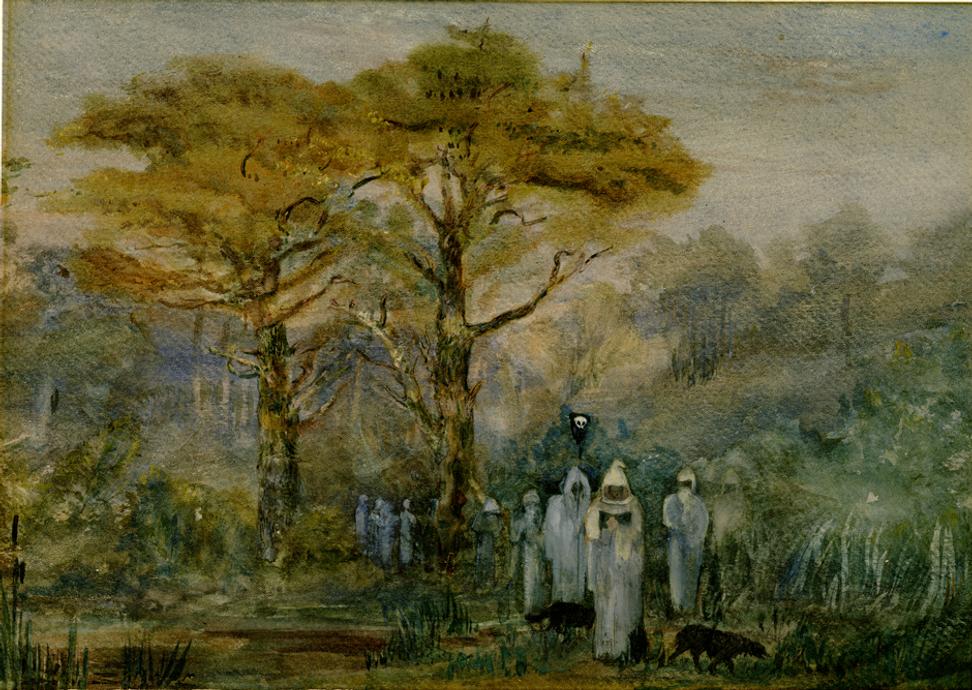
A hooded Procession, not dated. Barbara Leigh Smith Bodichon (1827–1891). Watercolor on paper, 10 1/16 × 14 9/16 inches. Mark Samuels Lasner Collection, University of Delaware Library.
February 3, 2019 at Delaware Art Museum.
Barbara Leigh Smith Bodichon (1827–1891) was an early female painter in the Pre-Raphaelite movement and ardent women’s rights campaigner. Landscape was Bodichon’s preferred genre, and her style reflects Pre-Raphaelite principles of careful observation and detailed rendering. Bodichon traveled widely and exhibited at the Royal Academy and Gambart’s French Gallery in Pall Mall, London, among other venues.
Throughout her life she was a tireless reformer and champion of women’s rights. In 1854, she published her A Brief Summary in Plain Language of the Most Important Laws Concerning Women , which was later used to promote the passage of the Married Women’s Property Act 1882. In 1858, she set up the English Woman’s Journal and in 1866, with Emily Davies, developed a strategy to extend university education to women, resulting in the founding of Girton College, Cambridge.
An inheritance from her father, radical Whig politician Ben Leigh Smith, allowed her an independence that was almost unheard of for a woman of the Victorian age. She was a true original spirit, ignoring class and gender restrictions. Rossetti described her as “blessed with… enthusiasm, & golden hair, who thinks nothing of climbing up a mountain in breeches or wading through a stream in none, in the sacred name of pigment.”
In 2016, the Delaware Art Museum acquired the watercolor Ventnor, Isle of Wight (1856), which became the inspiration for this exhibition. Bodichon’s working process will be examined and feature watercolor sketches and drawings from her travels.

Ventnor, Isle of Wight. Miss Barbara Bodichon, née Leigh Smith (1827-1891). Watercolour and bodycolour with scratching out, 28 x 42.5 inches; signed, inscribed and dated 1856. Provenance: Christopher Wood, London Exhibited: Royal Academy, 1956, no. 913; Manchester City Art Gallery, November 1997: 'Pre-Raphaelite Women Artists.'
In 1856 the artist, then Barbara Leigh-Smith (she married
the next year), stayed with her friend Anna Mary Howitt, also an
artist, on the Isle of Wight and painted this picture. Howitt had
attended Henry Sass’ art academy in 1846 with Holman Hunt and Rossetti, and the Pre-Raphaelites were regular visitors to her house in Highgate. Barbara Leigh-Smith was the illegitimate daughter of the radical Whig politician Ben Leigh Smith and Anne Longden, a milliner from Alfreton. Her first cousin was Florence Nightingale.
Well educated, intelligent and forceful, Leigh-Smith became with Howitt
one of ‘The Ladies of Langham Place’ that met regularly in London to
discuss women’s rights. In 1854, she published her Brief Summary of the Laws of England Concerning Women, which was later used to promote the passage of the Married Women’s Property Act 1882. In 1858, she set up the English Women’s Journal,
concerning employment and equality issues for women. In 1866, with
Emily Davies, she came up with a scheme to extend university education
to women. The first small experiment in this at Hitchin developed into Girton College, Cambridge, to which Mrs Bodichon gave liberally of her time and money.
The picture was well received at the Royal Academy; W M Rossetti
described it as a ‘capital coast scene, full of real
pre-Raphaelitism’.
Robin McInnes has identified the viewpoint to near Luccombe, just to the east of Ventnor, looking northeast across Shanklin Bay to Culver Cliff in the far distance, and suggested that the headland in the middle distance (which has been placed where it should not be) is Woody Point to the west of Ventnor, transposed for artistic effect.
The Maas Gallery, 15a Clifford Street, London W1S 4JZ has most generously given its permission to use in the Victorian Web
information, images, and text from its catalogues, and this generosity
has led to the creation of many valuable documents on painting and
drawing. The copyright on text and images from their catalogues
remains, of course, with the Gallery. Readers should consult their website to obtain information about recent exhibitions and to order their catalogues. [GPL]
The approximately 30 works are drawn from the Mark Samuels Lasner Collection at the University of Delaware and recent acquisitions in the Museum’s permanent collection.
This exhibition is organized by the Delaware Art Museum with financial support provided, in part, by a grant from the Delaware Division of the Arts, a state agency, in partnership with the National Endowment for the Arts. The Division promotes Delaware arts events on www.DelawareScene.com.
Wildflowers, not dated. Barbara Leigh Smith Bodichon (1827–1891). Watercolor and graphite on wove paper, 11 9/16 × 8 3/4 inches. Delaware Art Museum, Acquisition Fund, 2017.
Pear, not dated. Barbara Leigh Smith Bodichon (1827–1891). Watercolor and graphite on wove paper, 9 13/16 × 6 3/4 inches. Delaware Art Museum, Acquisition Fund, 2017.
Parasol pink mountains sky background pink, not dated. Barbara Leigh Smith Bodichon (1827–1891). Watercolor on paper mounted, 8 1/8 × 14 1/4 inches. Delaware Art Museum, Acquisition Fund, 2017:


